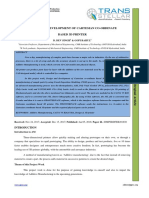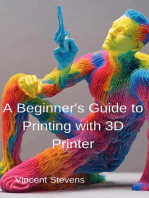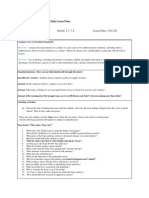3D Printing
3D Printing
Uploaded by
h64khndzjsCopyright:
Available Formats
3D Printing
3D Printing
Uploaded by
h64khndzjsOriginal Title
Copyright
Available Formats
Share this document
Did you find this document useful?
Is this content inappropriate?
Copyright:
Available Formats
3D Printing
3D Printing
Uploaded by
h64khndzjsCopyright:
Available Formats
Search
3D Printing
Sep 15, 2014 • Download as PPT, PDF
6 likes • 5,183 views
This computer graphics presentation covers the
Read
area of 3D printing. Please 'Like' if you find more
stu! …
Gallery
More Related Content
What's hot (20)
3DPrinting Technologies
Hamzah Meraj, Faculty of Archit…
13.9K views • 20 slides
3d printing
Bhumika Marolia
54.5K views • 23 slides
Additive Manufacturing
(3-D printing) , Rapid …
Prototyping
Dr. A.P.J. Abdul Kalam Technical …
6.6K views • 32 slides
Similar to 3D Printing (20)
3D Printing
Rehan Fazal
7.6K views • 30 slides
Chet deewan's ppt
PPT4U
2.7K views • 28 slides
3D Printing
Usman Bashir
164 views • 32 slides
Slideshows for you (20)
ppt about chatgpt.pptx
Srinivas237938
49.1K views • 15 slides
Design thinking
Vlad Posea
60.8K views • 48 slides
Introduction to ChatGPT
Damian T. Gordon
7.5K views • 38 slides
Recently uploaded (20)
Grade 7-TLE-AFA Lesson
3: Applying Safety …
Measures in farm
Sir J.
Operations-MATATAG...
358 views • 32 slides
Relational Database
Management System …
(RDBMS) LAB - GROUP B
Murugan146644
514 views • 96 slides
How to Customize
Report Using Studio in…
Odoo 17
Celine George
486 views • 15 slides
Related Books
Free with a 30 day trial from Everand View All
Ebook Ebook
301 Top Tips for 3D Printing 101:
Design Enginee… The Ultimate…
Chris Morris
To Help You Johannes
BeginnersWildGuide
★★★★★
'Measure Up' in ☆☆☆☆☆
5/5 0/5
the World of
Engineering
Related Audiobooks
Free with a 30 day trial from Everand View All
Audiobook Audiobook
HBR's 10 Must Computational
Reads on AI,… Thinking
Michael E. Porter
Analytics, and the Peter J. Denning
★★★★☆
New Machine Age ★★★★☆
4/5 4/5
3D Printing
1. 3D Printing Varun Luthra & Vipul Sharma CSE-5D ITM University
2. Introduction 3D printing is a form of additive manufacturing
technology where a three dimensional object is created by laying
down successive layers of material. It is also known as rapid
prototyping, is a mechanized method whereby 3D objects are
quickly made on a reasonably sized machine connected to a
computer containing blueprints for the object. 3D Printers are
machines that produce physical 3D models from digital data by
printing layer by layer. It can make physical models of objects either
designed with a CAD program or scanned with a 3D Scanner. The
basic principles include materials cartridges, flexibility of output,
and translation of code into a visible pattern.
3. Definition: 3D + Printing = 3D Printing 3D Printing is a phrase
used to describe the process of creating three objects from digital
file using a materials printer, in a manner similar to printing images
on paper.
4. Printing Process Printing is a process for reproducing text and
images, typically with ink on paper using a print press.
5. History of 3D Printing • The technology for printing physical 3D
objects from digital data was first developed by Charles Hull in 1984.
He named the technique as Stereo lithography and obtained a
patent for the technique in 1986. • While Stereo lithography systems
had become popular by the end of 1980s, other similar technologies
such as Fused Deposition Modeling (FDM) and Selective Laser
Sintering (SLS) were introduced.
6. Di!erent Methods Selective Laser Sintering (SLS) Stereo
Lithography Fused Deposition Modeling (FDM) Laminated Object
Manufacturing
7. SLS Method Selective Laser Sintering (SLS) is an additive
manufacturing technique that uses a high power laser (for example,
a carbon dioxide laser) to fuse small particles of plastic, metal
(direct metal laser sintering),ceramic or glass powders into a mass
that has a desired 3-dimensional shape).
8. SLS Method
9. Stereo Lithography Stereo lithography is an additive
manufacturing process using a vat of liquid UV-curable
photopolymer ”resin” and a UV laser to build parts a layer at a time.
10. Fused Deposition Modeling Fused deposition modeling (FDM)
is an additive manufacturing technology commonly used for
modeling, prototyping, and production applications.
11. Laminated Object Manufacturing Laminated object
manufacturing (LOM) is a rapid prototyping system developed by
Helices Inc. In it, layers of adhesive-coated paper, plastic or metal
laminates are successively glued together and cut to shape with a
knife or laser cutter.
12. World’s First 3D Printed Plane
13. 3D Printing Capabilities As anticipated, this modern
technology has smoothed the path for numerous new possibilities
in various fields. The list below details the advantages of 3D printing
in certain fields. 1.In Medical Field, Surgeons are using 3d printing
machines to print body parts for reference before complex
surgeries. Other machines are used to construct bone gra!s for
patients who have su"ered traumatic injuries. 2.Architects need to
create mockups of their designs. 3D printing allows them to come
up with these mockups in a short period of time and with a higher
degree of accuracy. 3.3D printing allows artists to create objects that
would be incredibly di"icult, costly, or time intensive using
traditional processes.
14. Success Stories Auto parts: For example, parts of "Formula 1"
car engines, are made by direct laser sintering of metal; Aircra!
parts: F-18 (fight aircra!) tube for the control system environment;
Individual Orthodontics: The company Align Technology uses the
3D Printing to generate accurate individual dental braces for
hundreds of thousands of patients worldwide by stereo lithography
from 3D-scans of the mouth.
15. Success Stories 3D printed Jaw
17. Conclusion Relatively New Technology. No restrictions on
industry. Significant decrease in product development cycle and
costs. Full e"ects on business and society still not know.
Resistance to change.
18. Thank You!!
Download now
About Support Terms Privacy
Copyright Cookie Preferences
English
Do not sell or share my personal information
Everand
© 2024 SlideShare from Scribd
You might also like
- Swimming Pool Calculation: To Calculate Pipe SizingDocument21 pagesSwimming Pool Calculation: To Calculate Pipe SizingElia Mekdad100% (3)
- 3D PrintingDocument19 pages3D Printingashishchugh44100% (1)
- 3D Printing Course OverviewDocument8 pages3D Printing Course OverviewMarihan AliNo ratings yet
- 3D PrintingDocument21 pages3D PrintingOM PRAKASH SRIVASTAVANo ratings yet
- Markov Decision ProcessDocument8 pagesMarkov Decision Processkailashnaidu07No ratings yet
- Module 1 - Introduction, 3D Printing Hardware, 3D Printing SoftwareDocument140 pagesModule 1 - Introduction, 3D Printing Hardware, 3D Printing SoftwareNgọc Anh Trần100% (1)
- WWW SlideshareDocument2 pagesWWW Slidesharetapukar23No ratings yet
- 3D Printing The Definitive GuideDocument46 pages3D Printing The Definitive GuideHarry100% (6)
- 3D Printing SeminarDocument19 pages3D Printing SeminarManoj gowda kNo ratings yet
- BITS Pilani BITS Pilani: Pilani Campus Pilani CampusDocument19 pagesBITS Pilani BITS Pilani: Pilani Campus Pilani CampusAlap PatelNo ratings yet
- 3d Printing Basic Training 1Document37 pages3d Printing Basic Training 1araoyeolaoluNo ratings yet
- 3D Printing: Matthew Baird An-Hsiang Cheng Carrie Geiss Christopher RihaDocument30 pages3D Printing: Matthew Baird An-Hsiang Cheng Carrie Geiss Christopher RihaManveen BhullarNo ratings yet
- Mis Final Report 3d PrintingDocument14 pagesMis Final Report 3d PrintingvidyaNo ratings yet
- Seminar On: 3D PrintingDocument19 pagesSeminar On: 3D Printingdhanalakshmi k sNo ratings yet
- 3D PrinterDocument16 pages3D PrinterK.Ramesh Mechanical MIET INSTITUTIONSNo ratings yet
- Application of IT PPT 2Document1 pageApplication of IT PPT 2ibrahim.thakur3663No ratings yet
- 3D Printing V2Document17 pages3D Printing V2budhayan2005No ratings yet
- Design and Development of Cartesian Co-Ordinate Based 3D PrinterDocument8 pagesDesign and Development of Cartesian Co-Ordinate Based 3D PrinterTJPRC PublicationsNo ratings yet
- Acknowledgements: Technology, Ghaziabad, For His Helpful Attitude and Encouragement in Time To Time To Excel in OurDocument44 pagesAcknowledgements: Technology, Ghaziabad, For His Helpful Attitude and Encouragement in Time To Time To Excel in OurMohit GuptaNo ratings yet
- Week 10 - 1-Advance - Tech - 3D - PrintingDocument63 pagesWeek 10 - 1-Advance - Tech - 3D - PrintingJiaqi MEINo ratings yet
- 3D PrintingDocument19 pages3D PrintingAscentNo ratings yet
- 3d PrintingDocument18 pages3d PrintingAnand Kumar YadavNo ratings yet
- Mechatronic System Design Project: A 3D Printer Case Study: November 2015Document7 pagesMechatronic System Design Project: A 3D Printer Case Study: November 2015maitham100No ratings yet
- 3D PrintingDocument19 pages3D PrintingMadhukar SamathamNo ratings yet
- 3D Printing: Muhammed Ashiik S REG - NO 15040100 S5 ElectronicsDocument19 pages3D Printing: Muhammed Ashiik S REG - NO 15040100 S5 ElectronicsshadowhackerNo ratings yet
- 3D PrintingDocument17 pages3D PrintingYuvarajNo ratings yet
- Xometry Ultimate Guide To 3D PrintingDocument27 pagesXometry Ultimate Guide To 3D Printingjazzyz100% (1)
- 00-3D Printing1-StudentsDocument47 pages00-3D Printing1-StudentsEddehbiNo ratings yet
- Tools and EquipmentDocument1 pageTools and Equipmentzhxzsrkm6bNo ratings yet
- 2024 01 - Prompt 2 3D - GSDocument31 pages2024 01 - Prompt 2 3D - GSGerd SchwadererNo ratings yet
- 3D PrintingDocument18 pages3D PrintingkishanNo ratings yet
- Answers Questions 3d-PrintingDocument9 pagesAnswers Questions 3d-PrintingBongani MaphumuloNo ratings yet
- Introduction To 3D PrintingDocument27 pagesIntroduction To 3D PrintingRaja kumarNo ratings yet
- 3d Printing TechnologyDocument12 pages3d Printing TechnologyS R I K A N T HNo ratings yet
- 3D Printing Technology: Name:Mrunal Shethiya 140 Nikita Mohite 91 STD:BCOM IT First Year DGCC, SataraDocument18 pages3D Printing Technology: Name:Mrunal Shethiya 140 Nikita Mohite 91 STD:BCOM IT First Year DGCC, SataraMRUNAL SHETHIYANo ratings yet
- 3D PrintingDocument26 pages3D PrintingKAMALNo ratings yet
- 3D PrintingDocument19 pages3D PrintingvindhNo ratings yet
- Curl SlideshowDocument37 pagesCurl SlideshowLourens SchlebuschNo ratings yet
- FinalDocument19 pagesFinalvanitha nNo ratings yet
- TOP 250+ 3d Printing Interview Questions and Answers 15 June 2022 - 3d Printing Interview Questions - Wisdom Jobs IndiaDocument31 pagesTOP 250+ 3d Printing Interview Questions and Answers 15 June 2022 - 3d Printing Interview Questions - Wisdom Jobs IndiaTahaNo ratings yet
- 3D PrintingDocument25 pages3D PrintingAnonymous PzbYdcEzNo ratings yet
- 3D Printing PPT 2 ReviewDocument17 pages3D Printing PPT 2 ReviewSSãï Pãvãñ KümãrNo ratings yet
- 3D PrintingDocument26 pages3D Printing9986212378No ratings yet
- 3D PrintingDocument26 pages3D PrintingRalucaJulaNo ratings yet
- Howo Electrical System.pptxDocument4 pagesHowo Electrical System.pptxBashir bashir0% (1)
- Cs329s 01 SlidesDocument70 pagesCs329s 01 Slidestribasuki74No ratings yet
- Engineering Seminar Topics:: Seminar Paper: 3D Printing TechnologyDocument6 pagesEngineering Seminar Topics:: Seminar Paper: 3D Printing TechnologyAyush SinghalNo ratings yet
- On 3D PrinterDocument21 pagesOn 3D PrinterAshish KumarNo ratings yet
- Basics of 3D Printing PDFDocument62 pagesBasics of 3D Printing PDFnihco gallo100% (7)
- Lecture 0Document18 pagesLecture 0Yau Ling Chen (Anson 陳佑甯)No ratings yet
- IntroToCG 09 25 04Document52 pagesIntroToCG 09 25 04sahuashishcsNo ratings yet
- Rapid PrototypingDocument36 pagesRapid PrototypingPebo GreenNo ratings yet
- 3D Printing-Indstrial Center of Jiangsu University-SHU HUANGDocument86 pages3D Printing-Indstrial Center of Jiangsu University-SHU HUANGAbdul Muhjib AfolabiNo ratings yet
- Assigment 1Document8 pagesAssigment 1sharanaaman26No ratings yet
- Introduction To 3D Printing Technologies.: Presented By: Manoj Kumar.mDocument63 pagesIntroduction To 3D Printing Technologies.: Presented By: Manoj Kumar.mTerminator941988No ratings yet
- Experiment # 3: Part Manufacturing Using 3D PrintingDocument12 pagesExperiment # 3: Part Manufacturing Using 3D PrintingMuhammad FarhanNo ratings yet
- 3-D Printing (1) 1Document17 pages3-D Printing (1) 1Mohith MathiNo ratings yet
- 3D PrintingDocument26 pages3D PrintingAkshat kedawatNo ratings yet
- 3D Printing: A Seminar Report OnDocument19 pages3D Printing: A Seminar Report OnSidharth MethreNo ratings yet
- Simplifying 3D Printing with OpenSCAD: Design, build, and test OpenSCAD programs to bring your ideas to life using 3D printersFrom EverandSimplifying 3D Printing with OpenSCAD: Design, build, and test OpenSCAD programs to bring your ideas to life using 3D printersNo ratings yet
- Chemistry of FireDocument70 pagesChemistry of FireSanjay RemananNo ratings yet
- Accreditation Grading Metrics - Skills Ecosystem Guidelines10 - 04Document8 pagesAccreditation Grading Metrics - Skills Ecosystem Guidelines10 - 04Jagdish RajanNo ratings yet
- Die Beursie by Vincent OliphantCharacter MapDocument1 pageDie Beursie by Vincent OliphantCharacter MapfemtaciNo ratings yet
- 300+ TOP Industrial Dispute Act 1947 MCQs and Answers 2022Document6 pages300+ TOP Industrial Dispute Act 1947 MCQs and Answers 2022Pallavi Joshi100% (3)
- Design and Development of Semi-Automatic Dishwasher: AbstractDocument5 pagesDesign and Development of Semi-Automatic Dishwasher: AbstractAmna AkramNo ratings yet
- What Are Enzymes?Document11 pagesWhat Are Enzymes?krishnarajagopal2011No ratings yet
- Types of Nucleic Acids: Return To TOC 1Document95 pagesTypes of Nucleic Acids: Return To TOC 1Hey itsJam100% (1)
- Floriculture Industry in IndiaDocument24 pagesFloriculture Industry in IndiaMuhammad Bilal BhatNo ratings yet
- Bran Gel in ADocument118 pagesBran Gel in Aferalesque0% (1)
- Saic A 1005Document2 pagesSaic A 1005Hussain Nasser Al- Nowiesser0% (1)
- Service Manual SM1-10-33.0: Outrigger/Steer Pump, R & IDocument4 pagesService Manual SM1-10-33.0: Outrigger/Steer Pump, R & IMohamed RashedNo ratings yet
- UV VIS Spectroscopy and SpectrophotometryDocument18 pagesUV VIS Spectroscopy and Spectrophotometrymajdkhashan999No ratings yet
- January 2022 Medical Technology Program of ExamDocument4 pagesJanuary 2022 Medical Technology Program of ExamTheSummitExpressNo ratings yet
- Vi. Discharge Care PlanDocument6 pagesVi. Discharge Care PlanHarvey T. Dato-onNo ratings yet
- RT-102 - Supply Unit Drain Pipes CloggingDocument7 pagesRT-102 - Supply Unit Drain Pipes CloggingYIU KWOK KeungNo ratings yet
- Types of Extraneous Variables - Bspsych2aDocument10 pagesTypes of Extraneous Variables - Bspsych2aJunayla Estares AzcarragaNo ratings yet
- Lecture - 1 - ES 302.ppsxDocument50 pagesLecture - 1 - ES 302.ppsxVipul MahajanNo ratings yet
- ASM Metals Handbook, NDT-Vol 17 10Document1 pageASM Metals Handbook, NDT-Vol 17 10xiaohao100% (1)
- KarthiksDocument41 pagesKarthiksShankarNo ratings yet
- Team 15 Major Project ReportDocument30 pagesTeam 15 Major Project ReportVarshik KasaniNo ratings yet
- DLL Mapeh-3 Q2 W1Document8 pagesDLL Mapeh-3 Q2 W1Cheza loriene VillarosaNo ratings yet
- TotalDocument3 pagesTotalHari KNo ratings yet
- PI e UREA 16Document2 pagesPI e UREA 16Moch Abdul RokimNo ratings yet
- How and Why To Search For Young Einsteins - Talent ShowsDocument6 pagesHow and Why To Search For Young Einsteins - Talent ShowsshoaibNo ratings yet
- Calf Fattening Farm Rs. 3.81 Million PDFDocument20 pagesCalf Fattening Farm Rs. 3.81 Million PDFMaira Shah100% (1)
- Memmert UIS English D10515Document24 pagesMemmert UIS English D10515Anggun Teh PamegetNo ratings yet
- DC Machine 3Document22 pagesDC Machine 3Mohammed AliNo ratings yet
- Review Trans Junjo PDFDocument22 pagesReview Trans Junjo PDFVaibhav MoonNo ratings yet
- Lesson Using TechnologyDocument2 pagesLesson Using TechnologybonnettscNo ratings yet

























































































